what to do if i find a copperhead in my yard
The centers for illness control estimate that 7,000 – 8,000 people are bitten by venomous snakes each year. Copperheads are responsible for more bites than any other venomous snake.
Babe copperhead bites are very painful, merely less than 0.01% are fatal.
Very few cases crave anti-venom to neutralize the venom, but infants, the elderly, and people with compromised immune systems, are at greatest take chances from complications.
Virtually bites occur from people accidentally stepping on them or picking them up.
In this guide we will teach you vii like shooting fish in a barrel means to identify this snake, how to safely remove them and how to prevent them from getting in your yard.

Table of Contents
- How To Identify A Infant Copperhead
- 1. Look At Their Tail-Tip Color
- 2. Look For An Hourglasses Blueprint
- 3. They Accept Facial Pits
- 4. They Have Vertical (Slitted) Pupils
- v. Practise They Take Keeled Scales?
- 6. Do They Have A Short Only Thick Body Type?
- 7. Look For Mail-Vent Scutes
- Snakes Ordinarily Dislocated For Copperheads
- How To Safely Remove Baby Copperheads
- Utilize A Hook
- Or Utilize A Clamp (Grab) Stick
- Culling Tools To Utilize
- Signs A Copperhead Is Stressed
- How To Stop Copperheads From Entering Your Yard
- Summary
How To Place A Infant Copperhead
At that place are many myths surrounding venomous snakes.
The biggest myth is that juveniles cannot control their venom and therefore bite with a larger amount than adults. This is false!
Baby copperheads take smaller venom glands and therefore hold a smaller amount of venom. However, they are as well still capable of venom metering – altering how much venom they inject based on their target'due south size.
The second myth is that all venomous snakes have triangular heads.
Pit vipers do have triangular heads as this is necessary to arrange their venom glands. However many nonvenomous snakes mimic this appearance by flattening their heads and extending their jaws.
Too, many snakes have perfectly narrow heads but are venomous. A good case is the Coral Serpent. These tiny snakes are the 2nd deadliest in the globe!
To help y'all identify this serpent nosotros have put together seven easy steps you lot tin can take.
1. Look At Their Tail-Tip Color
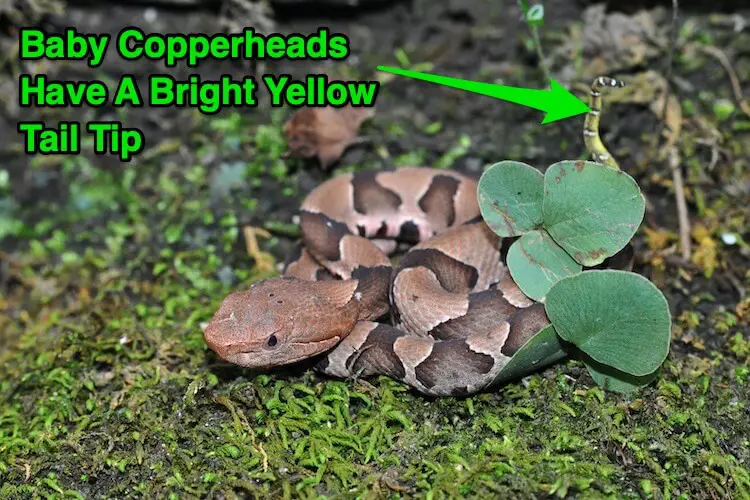
Many baby copperhead snakes are built-in with a bright yellowish or green tip to their tail.
This brilliant color is used to attract and lure prey to enter within hit altitude. This helps babies observe food and grow quickly.
Normally afterward one year their tail volition turn nighttime chocolate-brown or in some cases even blackness.
2. Look For An Hourglasses Pattern
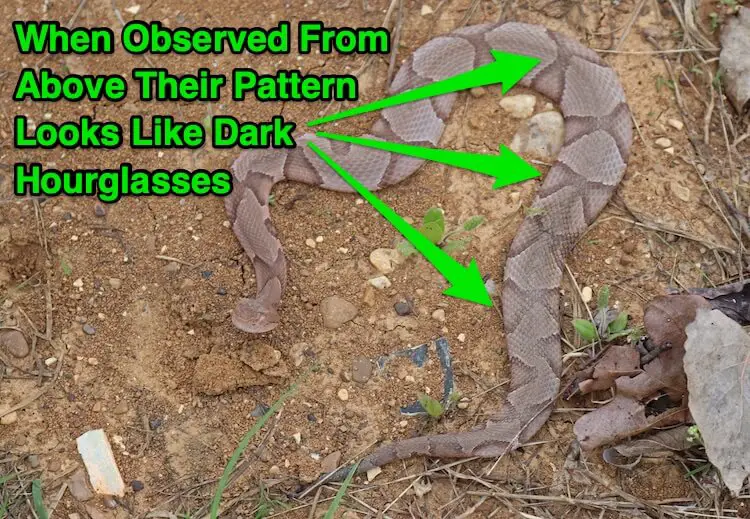
These snakes have a stake, pinkish-tan color and their heads are a remarkable copper tone (giving them their proper name).
Copperheads have a distinct design that stays uniform throughout their lives.
Their markings are night brown in color. The bands are thin over their spine and widen as they approach the sides of the belly. When observed from to a higher place, this blueprint looks similar nighttime hourglasses. When seen from the side, it looks like a row of Hershey's Buss chocolate candies.
The belly is white with dark brownish-crimson spots.
three. They Have Facial Pits
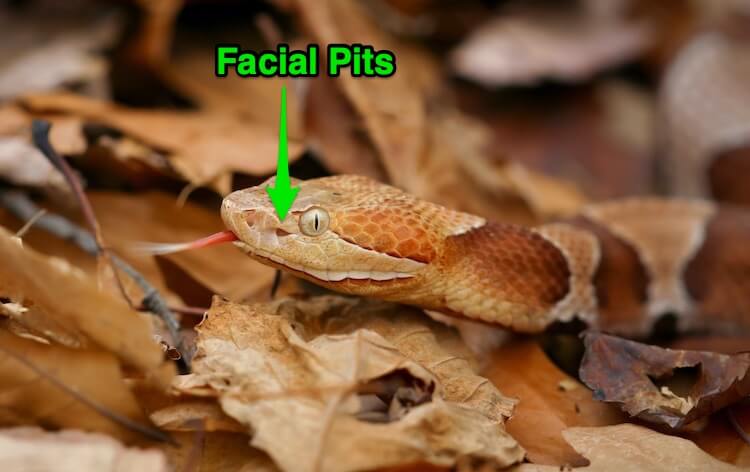
Copperheads are a fellow member of the pit viper family unit.
Pit vipers have a pair of estrus sensors either side of their face up between the eye and nostril.
These pit glands help snakes to find prey and thermoregulate.
Snake eyesight is notoriously poor. Without these glands finding prey past motion alone would exist very hard. Oestrus sensing allows them to run into the world in infrared.
Pits are obvious in shut-upwardly pictures, however, y'all will need to become very shut to a babe copperhead to be able to see its pits.
4. They Have Vertical (Slitted) Pupils
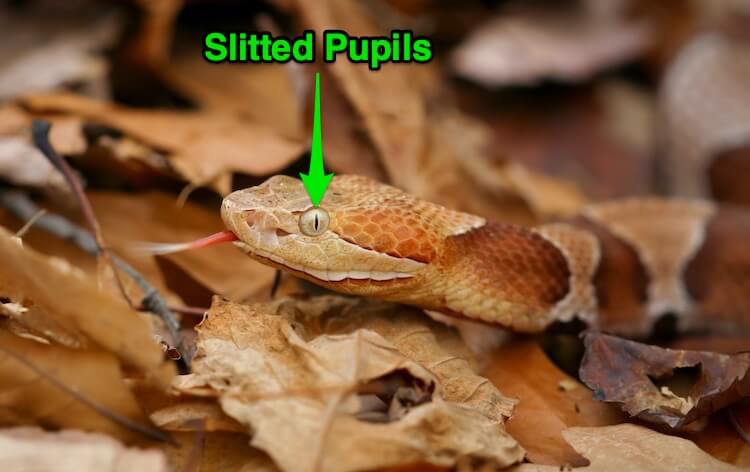
Most venomous snakes are known for their "cat-eye" pupils.
The pupils are slitted vertically, dissimilar the round pupils of nonvenomous snakes.
They have gilt-xanthous eyes with a thin black student slit down the eye.
Though beautiful to look at, they are best observed from a picture.
five. Do They Have Keeled Scales?
Keeled scales are raised scales that give snakes a crude texture. The scales have a ridge down the center that create a raised triangle shape.
Nearly all venomous snakes have keeled scales.
It tin exist hard to tell if a snake has keeled scales without touching.
Unless you have had proper preparation for handling venomous snakes it is not recommended to endeavour handling.
You should instead rely on their pattern, tail and other features apparent from a distance.
6. Do They Have A Short But Thick Torso Type?
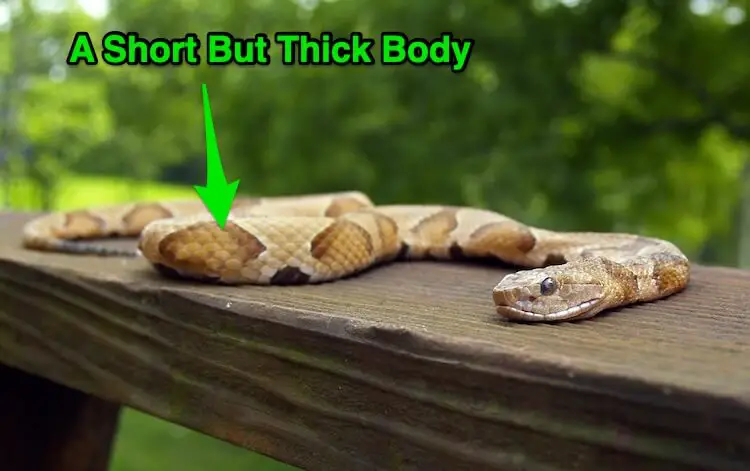
Like most venomous snakes, this snake has a short merely thick torso.
Baby copperheads are typically 7 – 10 inches long and adults reach 24 – 36 inches.
Babies are thin for the first three months. However, afterwards a steady food source is found, they rapidly abound to and take a thick body.
A copperhead at 24 inches may be as thick equally the circle formed when touching your pointer finger and thumb together.
vii. Look For Postal service-Vent Scutes
This last identification method is best left to experts because it is extremely hard (and never recommended) to flip a potentially dangerous snake over and examine its tail.
Well-nigh snakes become frantic and try to strike if you flip them over.
However, this is a guaranteed method to identify a baby copperhead.
Scutes are the long, straight scales that line the bellies of snakes and help with locomotion.
In a nonvenomous snake, the scutes after the vent are divided into two, giving a "zipper" appearance. In venomous snakes, there are unmarried, elongated scales past the vent.
Snakes Ordinarily Confused For Copperheads
The U.s. has over 125 species of snakes. Many are oft confused for copperheads because they look similar. The most common lookalikes are:
| Similar Snakes | |
|---|---|
| Juvenile Eastern Rat Ophidian | This species is normally gray and blackness with large spots over the spine. Non like the hourglass pattern higher up. |
| Juvenile Black Racer | Juvenile Black Racers look almost identical to the eastern rat snake (above). They take a darker gray base and more than chocolate-brown spots. |
| Northern H2o Ophidian | This species can exist separated because of their thick dark spinal bands and narrow dark bands towards the abdomen. Water Snakes may take bands that are completely broken as well. |
| Eastern Hognose | Hognoses are short, thick-bodied snakes that are totally harmless. They come in a variety of colors but have a busy, erratic pattern dissimilar the uniform blueprint in a higher place. |
| Cornsnake | Cornsnakes are normally vivid orange and red tones with big spinal spots. These spots do not meet the sides of the belly, unlike the hourglass above. |
| Juvenile Mole King Snake | Mole Kings typically have gray or tan base of operations colors with dark blood-red-brown spots over their spines. Every bit they historic period, they turn almost fully brown. |
You should now be able to identify and avoid mistaking other snakes for this species.
It is now time to remove and prevent this ophidian from entering your yard.
How To Safely Remove Baby Copperheads
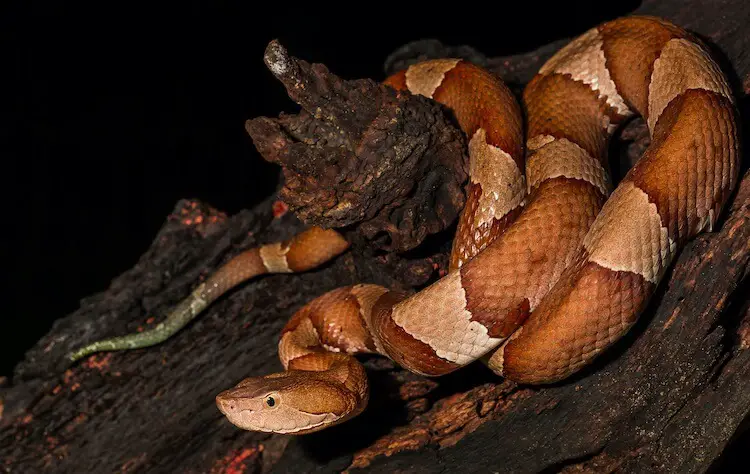
You have found a serpent in your yard and accept determined it is a Copperhead, what's adjacent?
If it is near the edge of your g, it will likely slither away on its own without intervention. So discover or walk abroad.
About snakes will just exist passing through.
However, if it needs to be moved, or y'all feel more than comfortable with knowing the snake isn't nigh your yard follow the steps below.
Employ A Claw
If you live in Copperhead country, it is useful to invest in ophidian handling devices.
This is the safest and least harmful mode to handle the ophidian. Your hook should be at least 3 feet long or more to create a "safe zone" betwixt you and the snake.
To use a hook, gently take the pointed end and slide information technology underneath the heart of the baby copperhead.
Elevator the snake up quickly enough that it is unable to slither off.
They are known to be fickle on hooks, so it may help to gently vibrate the claw to make them desire to hold on.
Place the snake in a big bucket or tub to movement it to a desired location.
If the snake keeps slipping off the claw, information technology may be necessary to use a clamp stick.
Or Utilize A Clamp (Grab) Stick
Grab sticks are very effective in picking up a snake and holding it securely.
A catch stick works the same fashion a trash grabber works, it only has a more ophidian-friendly clamp. The handle has a trigger that is continued to a pulley that closes the clench.
To pick upwardly the snake:
- Slide the lesser arm of the clamp under the heart of the snake's body.
- Slowly, only firmly, close the clamp around the snake.
- Avoid squeezing the clamp too hard or too quickly, every bit this can sometimes break the snake's dorsum or ribs.
- In one case secured, you tin can so relocate it or move it into a bucket for safe relocation.
Do not take hold of the cervix or tail region with either a hook or clamp! Handling a snake in these areas can cause impairment to the spine or neck, permanently injure or even kill.
Alternative Tools To Use
If yous are surprised to find a baby copperhead in your yard, and exercise not have a hook or grab stick, there are culling tools y'all can apply.
Find a long (3 or more anxiety) object to either pick upwards the snake with.
The key is to maintain a safe distance and avoid injuring the ophidian.
Ane choice is to use a shovel to scoop the snake up and identify it in a saucepan. This gives you plenty of space to create a safe zone around the serpent.
If the snake keeps slithering off before yous can get information technology into a saucepan, you can attempt using the shovel to gently push the snake into an overturned bucket. Using the shovel push the bucket right-side up to trap the serpent inside.
You tin can besides sweep the ophidian into a bucket if it is on a smooth surface. Again, the fundamental is to create a 3 human foot safe zone betwixt yourself and the snake.
Signs A Copperhead Is Stressed
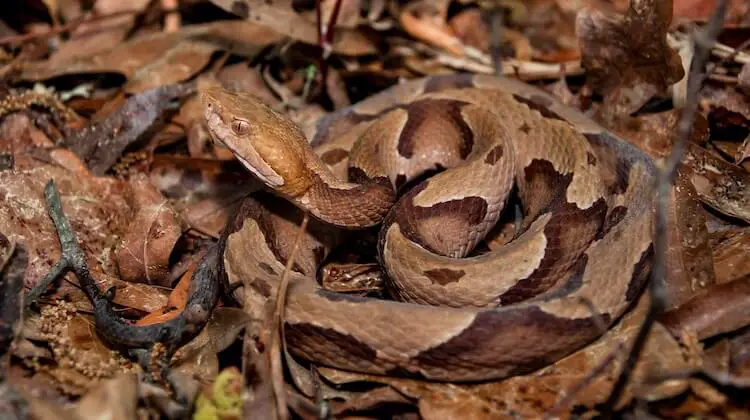
Moving and re-locating a snake tin be a stressful time.
Copperheads may react in a diversity of ways when they feel threatened.
Recognizing these signs can tell you when the serpent is probable to bite or needs a moment to calm downwards:
- Coiling up and shaking their tail.
- Striking out.
- Trying to slither away.
- Mouth breathing or hissing.
- Musking (releasing a pungent disgusting smelling liquid).
If you observe the ophidian showing any of these behaviors they are likely to bite. Step back and requite the snake time to calm down before trying to capture again.
How To Stop Copperheads From Entering Your Yard
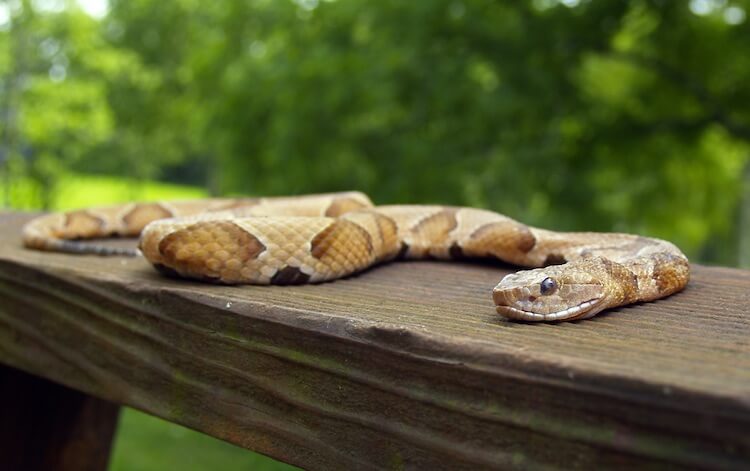
The best way to get rid of Copperheads is to forbid them from nesting in your yard at all.
Snakes prefer to be hidden. The most important factor in preventing them from entering your thou is the grass.
When you let your grass abound, snakes feel safer.
A regularly mowed backyard volition deter about snakes from wanting to travel across information technology. If you lot happen to step on a traveling venomous serpent it is likely to ruin your day.
People who repeatedly notice snakes in their yards typically have accidentally given them housing by assuasive their grass to grow.
To serpent-proof your yard:
- Walk around the base of your house and look for whatsoever hole they could go in (they await for absurd, dark places to hibernate during the heat of the 24-hour interval).
- Fill in any holes or gaps. This will stop them from beingness able to nest shut to your home.
- Rake brush and leaves.
- Many people ignore bushes when doing yardwork considering they tend to hibernate the underbrush that collects beneath them. The problem? All that brush is a perfect hiding identify.
If you feel like yous even so run across as well many snakes after using these methods, then you can use physical deterrents. Ophidian fences are the well-nigh constructive deterrent, since they prevent the snake from entering the 1000 at all, though they still aren't failproof.
Never use commercial traps as they are normally unsuccessful and the crushing machinery can severely injure the snake. These contraptions are inhumane and are non recommended.
Summary
Bites from copperheads are not fatal, but they are painful. They tin can take weeks to heal and sometimes require expensive anti-venom treatment.
The all-time style to prevent a bite is to avoid them altogether.
Knowing how to identify this species will help you understand when to act. If you identify a snake as a baby copperhead, remember to keep your three feet safe zone!
When attempting to remove them brand sure to use safe methods and tools such every bit hooks, catch sticks, or shovels.
Be gentle and realize that the snake is just equally stressed as you are. Slow movements volition help them stay at-home.
Lastly, you should prevent them from nesting in your 1000 by keeping a well maintained lawn, removing ataxia and filling in holes.
Do you feel like you lot tin successfully identify this serpent? Are you prepared to safely remove them?
Let u.s.a. know how you feel about information technology in the comments!
Source: https://www.everythingreptiles.com/baby-copperhead/